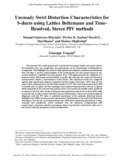JavaScript is disabled for your browser. Some features of this site may not work without it.
| dc.contributor.author | Guerrero-Hurtado, Manuel | |
| dc.contributor.author | Zachos, Pavlos | |
| dc.contributor.author | MacManus, David G. | |
| dc.contributor.author | Migliorini, Matteo | |
| dc.contributor.author | Trapani, Giuseppe | |
| dc.date.accessioned | 2019-10-18T11:50:26Z | |
| dc.date.available | 2019-10-18T11:50:26Z | |
| dc.date.issued | 2019-08-16 | |
| dc.identifier.citation | Guerrero-Hurtado M, Zachos PK, MacManus DG, et al., (2019) Unsteady swirl distortion characteristics for S-ducts using Lattice Boltzmann and time-resolved, stereo PIV methods. In: AIAA Propulsion and Energy 2019 Forum, 19-22 August 2019, Indianapolis, IN, USA | en_UK |
| dc.identifier.issn | 978-1-62410-590-6 | |
| dc.identifier.uri | https://doi.org/10.2514/6.2019-4275 | |
| dc.identifier.uri | https://dspace.lib.cranfield.ac.uk/handle/1826/14623 | |
| dc.description.abstract | The unsteady flowfields generated by convoluted aero engine intakes are major sources of instabilities that can compromise the performance of the downstream turbomachinery components. This highlights theneed for high spatial and temporal resolution measurements that will allow a greater understanding of the aerodynamics but also improvements in our current predictive capability for such complex flows. This paper presents the validation of a modern Lattice Boltzmann method (LBM)to predict the unsteady flow and swirl distortion characteristics within a representative S-duct intake.The numerical results are compared against high spatial and temporal resolutionParticle Image Velocimetry(PIV)data for the same S-duct configuration at an inlet Mach number of0.27.The work demonstrates that LBM is broadly able to capture the flow topologies and temporal characteristics with the exception of the magnitude of the unsteady fluctuations which were found to be notably under-predicted compared to the PIV data. Proper Orthogonal Decomposition analysis shows that LBM is able to provide the key flow modes and their spectral distributions which were found broadly in alignment with the PIV data. A statistical assessment of the unsteady distortionhistoryhighlights that LBM can also provide representative distributions of the main swirl distortion descriptors. Overall the work demonstrates that LBM shows promising potential for S-duct unsteady flow predictions which combined with the minimum computational grid requirements, robustness and fast convergence make it an attractive solution for wider use in thearea of unsteady propulsion system aerodynamics. | en_UK |
| dc.language.iso | en | en_UK |
| dc.publisher | AIAA | en_UK |
| dc.relation.ispartofseries | ;AIAA-2019-4275 | |
| dc.rights | Attribution-NonCommercial 4.0 International | * |
| dc.rights.uri | http://creativecommons.org/licenses/by-nc/4.0/ | * |
| dc.title | Unsteady swirl distortion characteristics for S-ducts using Lattice Boltzmann and time-resolved, stereo PIV methods | en_UK |
| dc.type | Conference paper | en_UK |
Files in this item
The following license files are associated with this item:
This item appears in the following Collection(s)
-
Staff publications (SATM) [4365]

